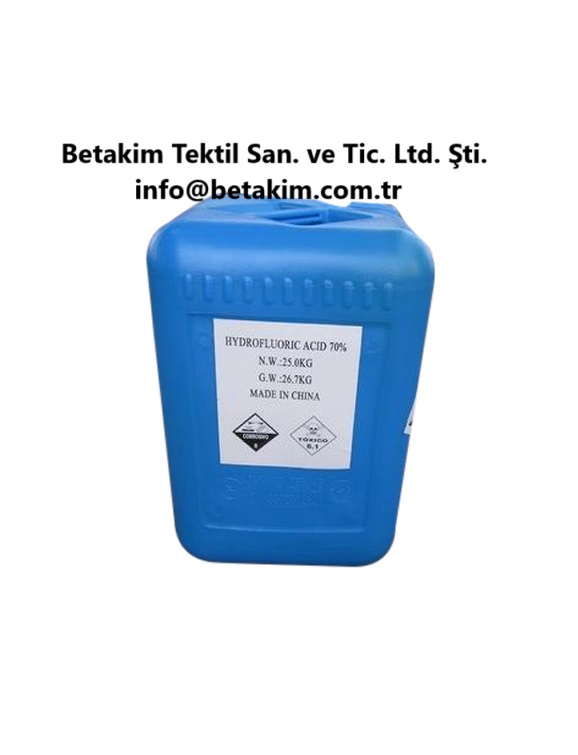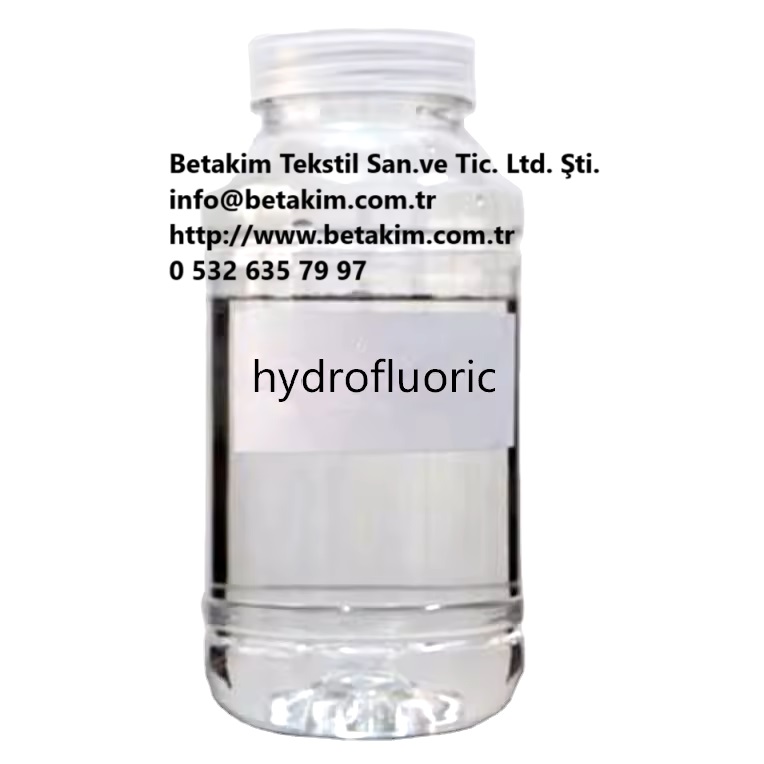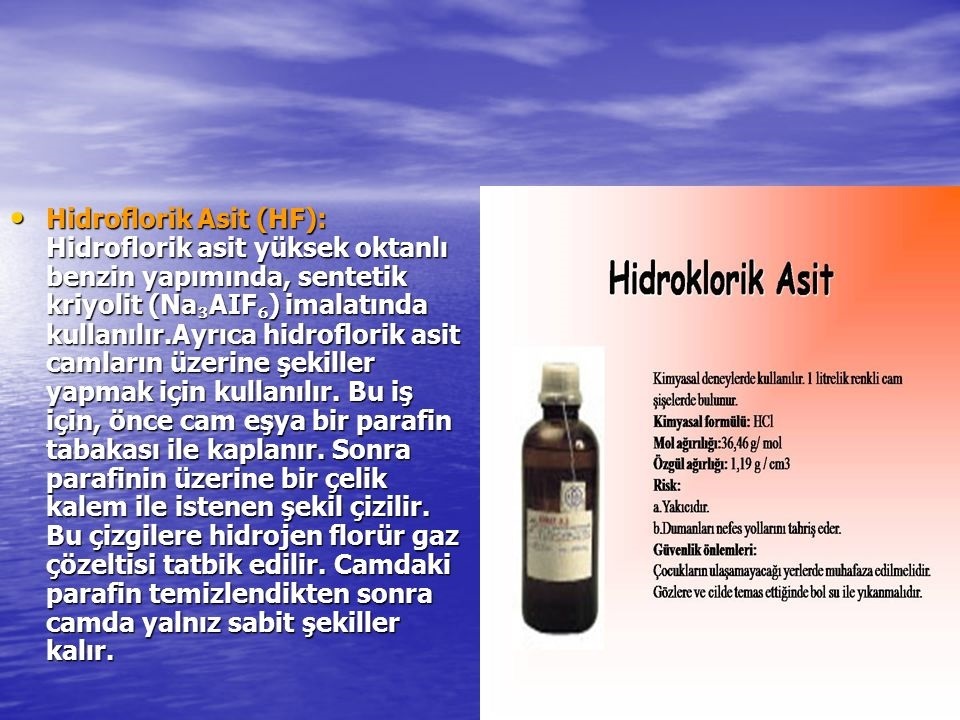We unleash your business potential by maximize the business innovation.
Send EmailHydrofluoric Acid, Fluorhydric Acid, Hydrogen Fluoride, 7664-39-3
Products overview:
| Product | Hydrofluoric acid 55% |
| Material Shape | Liquid |
| Specification | 25kg/drum |
| Aqueous acid absorb | 58.45% |
| Original total acidity | 56.82% |
| H2SIF6 | 0.46% |
| HF | 56.44% |
Descriptions:
Hydrofluoric acid (HF) is an aqueous solution of hydrogen fluoride gas.
At room temperature, it appears as colorless transparent to light yellow smoke liquid with pungent odor. It has a specific gravity of 0.98 which is slightly lighter than water. It has a boiling point of 19.4 °C, being highly volatile. It can release white smoke once placed in air. The aqueous solution containing less than 60% hydrogen fluoride appears as a colorless clear fuming liquid. Industrial products are usually aqueous solution containing 40 to 45% HF.
It has pungent odor. It can react with sulfur trioxide or chlorosulfonic acid to generate fluoride sulfonic acid, and can react with halogenated aromatic hydrocarbons, alcohols, olefins, hydrocarbons to generate fluorine-containing organic compound. When being dissolved in water, it can produce highly corrosive acid, being medium-intensity acid. It is extremely smelly, being very toxic and is prone to cause ulceration when get touch with the skin with a severe extent being larger than any acids.
If inhaled of its vapor, it can have fatal effects, thus strict attention should paid during usage.
Hydrofluoric acid can also react with general metals, metal oxides, and hydroxide, generating a variety of metal fluoride salts, but the effect is not as dramatic as hydrochloric acid. Gold, platinum, lead, paraffin and some plastics (polyethylene, etc.) does not react with it and thus being able to be used as containers.
Strong corrosivenes
It can erode glass and silicate to produce gaseous silicon tetrafluoride. The reaction is as follows:
SiO2 + 4HF → H2O + SiF4 ↑,
glass is a silicon compound so the hydrofluoric acid can't be put into glass containers.Hydrofluoric acid can form acid salt, hydrofluoric acid is a monobasic acid, but can produce a series of acid salts such as NaHF2, KHF2, NH4HF2, which are the other three kinds of halogen acid.
The weak acidity of hydrofluoric acid; because of the strong binding capability of hydrogen atom with fluorine atom, hydrofluoric acid can't be completely dissociated in the water. In the hydrohalic acid, only hydrofluoric acid is weak acid (its ionization constant is 3.5 × 10 ^-4; its apparent ionization degree is about 10% at a concentration of 0.1mo1.L^-1, therefore, HF can reluctantly taken as a kind of strong acid. The ionization degree at high concentration is higher than that at low concentration. This property is different from other kinds of general weak electrolytes.
Application:
1. Mainly used as a raw material for fluorinated compounds, but also for the manufacture of aluminum fluoride and cryolite, semiconductor surface etching and as a catalyst for alkylation.
2. Used as a strong acidic etchant in the electronics industry, it can be used with nitric acid, acetic acid, ammonia and hydrogen peroxide.
3. Used as an analytical reagent, but also for the preparation of high purity fluoride.
4. It is a necessary fluorine source for fluorine salts, fluorine refrigerants, fluorine plastics, fluorine rubber, fluorine medicine and pesticides.
5. It is the raw material for the production of refrigerant "freon", fluorine-containing resin, organic fluoride and fluorine. It can be used as catalyst for alkylation, polymerization, condensation, isomerization and other organic synthesis in chemical production.
6. For the manufacture of organic or inorganic fluorides, such as fluorocarbons, sodium fluoride, aluminum fluoride, uranium hexafluoride and cryolite.
7. Used for etching glass, pickling metal, making inorganic fluorine salt products and chemical reagents.
8. Used in atomic energy industry, elemental fluorine, fluoride, can also be used as a catalyst, fluoride agent, etc.
9. For organic or inorganic fluoride.It is also used for stainless steel, non-ferrous metal pickling, glassware frosting and pickling, frosted light bulb treatment, etc.
10. Determination of silica, manufacture of fluoride, copper cleaners, metallurgical metallographic analysis, silicon compound analysis.
Molecular Formula (Hydrofluoric Acid); HF
Molecular Weight; 20.01 g/mol
Chemical Name; HF
CAS Number; 7664-39-3
The chemical formula of Hydrofluoric Acid is HF. Its molarity is 20.01 g/mol. The hydrogen fluoride compound is in gaseous form, but it is the solution-formed form of HF in water. The solution of hydrogen fluoride (HF) in water is called hydrofluoric acid. It is a chemical compound containing fluoride. When hydrogen fluoride (HF) is diluted with water, products are obtained in different concentrations. Hydrofluoric Acid can be found as a colorless gas, a steaming liquid or dissolved in water. Hydrogen fluoride is a molecule with a simple 2-atom structure.
Other names of Hydrofluoric Acid:
Hydrogen Fluoride
Fluorhydric Acid
Hydrochloride
Hydrogen Fluoride(HF)
Hypofluoric Acid
Hydrogen Fluoride
Fluorohydric Acid
Anhydrous Hydrogen Fluoride
Hydrofluoric Acid
Hydrofluoric Acid technical grade
Fluoride hydrogen
70% Hydrofluoric Acid
Physical Properties of Hydrofluoric Acid:
Pure Hydrogen Fluoride (HF) can be found as a colorless gas with a density of 1.15 g/L at 25 ° C (room temperature) or as a colorless liquid of 0.99 g/L (below 20 ° C). Its boiling point, melting point and density depend on the concentration of hydrogen fluoride (HF) in its solution.
Chemical Properties:
Hydrofluoric Acid is generally in the weak acid category. But its effects are extremely strong. Its concentrated solution is extremely reactive. It is in the acid category that causes corrosive effects. This chemical can interact very quickly with bases, acids and oxidizing agents. It is the form that has the highest tendency to enter into chemical reactions at the reactive level.
Where is Hydrofluoric Acid Used?
Hydrofluoric Acid should never be used without receiving training from an expert who has technical knowledge and detailed information about this chemical. All properties of this chemical should be explained to the user in detail.
It is used in the production of refrigerants and in the production of Teflon (PTFE Plastic).
If the welding stains that occur in stainless steel welding with argon welding are not removed, they cause corrosion over time and welding gels are used to remove this. It is used with Nitric Acid in the production of these welding gels.
It is used in the preparation of fluorocarbons and many fluorine compounds.
It is used in the glass manufacturing sector to shape the glass by abrading it. It is used with Sulfuric acid to polish the glass and ensure smoothness. In this application, it is processed by immersion in an acid bath.
It is used in the metal coating sector for the purpose of cleaning the metal and removing rust by mixing it with Sulfuric acid.
In semiconductor manufacturing enterprises, cleaning is done with its solution to clean silicon plates. In semiconductor production, after one surface of the stack structure comes into contact with Hydrogen Peroxide, the excessive layers on the surface of the stack structures are cleaned.
It is used to increase the octane number in the production of high-octane fuel for aircraft and automobiles.
Other Areas of Use;
It is used for purification purposes in the production of some substances in countries with nuclear power.
It is used to produce fluoroaromatic compounds. These are 2-fluoroaminobenzene, 2,4 difluoroaminebenzene and trifluoromethylbenzene. These compounds are used in very different and diverse sectors.
For example, it is used in the production of chemical compounds used as intermediates in the production of antidepressants and insecticides.
Hydrofluoric acid is used to produce liquid crystals used in LCD television screens, computer monitors and mobile phone monitors that have now entered our lives.
In the production of cover glass of mobile phones or laptops, an etchant process is applied together with hydrochloric acid in the smoothing process of both surfaces. It is inflated with Sodium Hydroxide to remove hydrofluoric acid from the glass surface.
It is the most important compound in the production of alkanes from smaller alkenes.
In order to produce crude oil and natural gas from underground wells and to facilitate the production of oil and gas, an acidic environment must be created in the wells. During the creation of this acidic environment, organic acids with a pKa value of less than 1 are used. The efficiency increases as the duration of the acid in the well increases. The acids used here should be Hydrofluoric Acid, Hydrochloric acid or ammonium bifluoride, a compound that will give HF when dissolved in water.
It is used to produce Uranium (IV) fluoride (UF4) from Uranium Oxide (U2O3) during the reactive level Uranium enrichment process.
It is used in the production of alkyl benzene sulfonates used as surfactants in detergents classified as anionic.
In acid baths used in stainless steel sheet and stainless pipe manufacturing, 60%-70% Hydrofluoric Acid and Nitric Acid are mixed.
The connection points of stainless pipes are connected with gas welding or argon welding. In order to remove the welding stains that occur after the welding process, a solution is created with nitric acid and these stains are removed. Blasting is done.
It is used in the separation of silicon dioxide during silicon production.
The concentration of the product is important. In some areas, low-concentration hydrofluoric acid is used. This ratio can be 40%.
In oil and gas wells, one of the acids with a low pH level is used to characterize sandstone formations and to ensure that oil and gas can be extracted more easily. These are strong acids.



